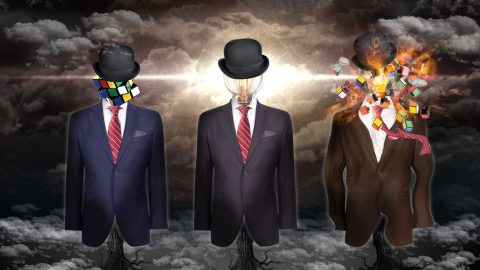Thought experiments: A surefire way to stretch your team’s creativity

Quick! There’s a runaway train on the tracks. Some dastardly evildoer has knocked the driver out cold and tied five people to the tracks ahead. The train is barreling down on them, and unless something is done, they will be killed.
You happen to be in the train yard standing next to a switch. The switch will divert the train onto a sidetrack, sparing those people a terrible, gory death. But there’s a catch! A sixth person is tied up on this sidetrack. You have two options: You can do nothing and allow the train to kill five people or you can pull the lever, diverting the train and killing one person.
What is the right thing to do?
At this point, you’re probably wondering, “What the heck did I do to get myself in this unenviable position?” The answer is that you did something most ill-advised: You struck up a conversation with a philosopher. Now, you’re in the world of the thought experiment.
Philosophers love thought experiments. They’re cuckoo for them. They use these devices of the imagination to work through problems, explore hypotheses, argue with each other’s ideas, and predict the consequences of potential actions.
Consider the homicidal dilemma above, known as the trolly problem. Ethics philosophers devised this thought experiment to gauge people’s moral intuition and reasoning. Some claim it is a moral obligation to switch the track. Killing one person is less reprehensible than letting five die. But others argue you should do nothing. Throwing the switch may save five lives, but it makes you responsible for one death.
It’s not just philosophers, either. Scientists, psychologists, and historians also utilize thought experiments to think through problems or illustrate difficult-to-grasp hypotheses. Einstein’s twin paradox is a well-known example in physics.
Philosopher Susan Schneider, author of Artificial You, thinks thought experiments can help our teams, too. In this lesson preview, she explains why:
Thought Experiment: An imagined scenario put forth for the purpose of eliciting a reasoned response to a complex question
- Thought experiments are meant to get people thinking. Use them to explore a concept or test the limits of a claim.
- Design thought experiments to help team members explore the contours of a problem: What logical issues come up? What tensions emerge between ideas?
If you want to add thought experiments to your team’s toolkit, there are a couple of things to note.
Tips for Creating Thought Experiments
First, thought experiments aren’t the same as roleplaying. In roleplaying, you embody a role that may or may not be your own—team leader, member of sales, elvish princeling, etc. You then play out that role in a pretend scenario to optimize performance and develop muscle memory so you can bring both into a real-life situation.
With thought experiments, however, your goal should be to derive principles more than practices. You can then use those principles to guide your mission, values, and, yes, practices.
For example, you could generate a thought experiment in which a new competitor arises. The competitor is underpricing the market and has a slick ad campaign, but their leadership is green and the product not to standard. Pose this hypothetical to your team (with added details) and get them to answer some form of Schneider’s questions above.
What’s the potential loss on your end? Can you improve on your product or develop a competitive alternative? How? Can you utilize network relationships? What are the consequences of each action proposed? What solutions are possible and within what timeframe? Dig deep and consider how things would play out and what the conclusions would likely be.
If role playing is learning to solve a Rubix cube by rote, then a thought experiment is considering the fundamentals of how the Rubix cube works. One is the act of solving the problem; the other a deep understanding of the problem and why certain solutions work or do not.
Second, thought experiments are devices of the imagination, and imaginations have been known to run wild. The trolly problem is a potential example of this. Some ethics philosophers argue that the scenario is so disconnected from reality that it can say little to nothing about how people make moral decisions.
You can also finely tune thought experiments to say what you want. This can make you feel better about a potential problem, proposition, or scenario but doesn’t produce the problem-solving effect we’re looking for.
For example, you may pose a thought experiment to explore your organization’s place ten years from now. But if your thought experiment poses a future no different than the present, you won’t get anywhere.
A helpful hint in designing thought experiments is to think like a game designer. Designers create worlds that pose problems to players—e.g., save the world from evil; manage your space station effectively; eat dots, don’t let ghosts eat you. These problems haven’t been encountered before, so the designer provides just enough information to get the player started. The problem must also be challenging (not impossible, not too easy) and leave room for intuition, exploration, and imagination.
Don’t let your organization be blindsided by unforeseeable problems like, say, a runaway trolley. Foster the creative problem-solving that will allow your team to be their best with video lessons ‘For Business‘ from Big Think+. Susan Schneider joins more than 150 experts to teach lessons on AI, innovation, problem-solving, and leading change. Check out these titles from our catalog:
- Use Intuition Pumps as a Testbed for Thinking, with Daniel C. Dennett, Philosopher, Writer and Cognitive Scientist, | Author, From Bacteria to Bach and Back
- Organize By Design: How to Think Like a Designer, with David Butler, VP, Innovation and Entrepreneurship, The Coca-Cola Company
- Empower Your People: Conversational Moves for Engaging Your Team in Creative Collaboration, with Diane Paulus, Tony Award-winning Director
Request a demo today!




